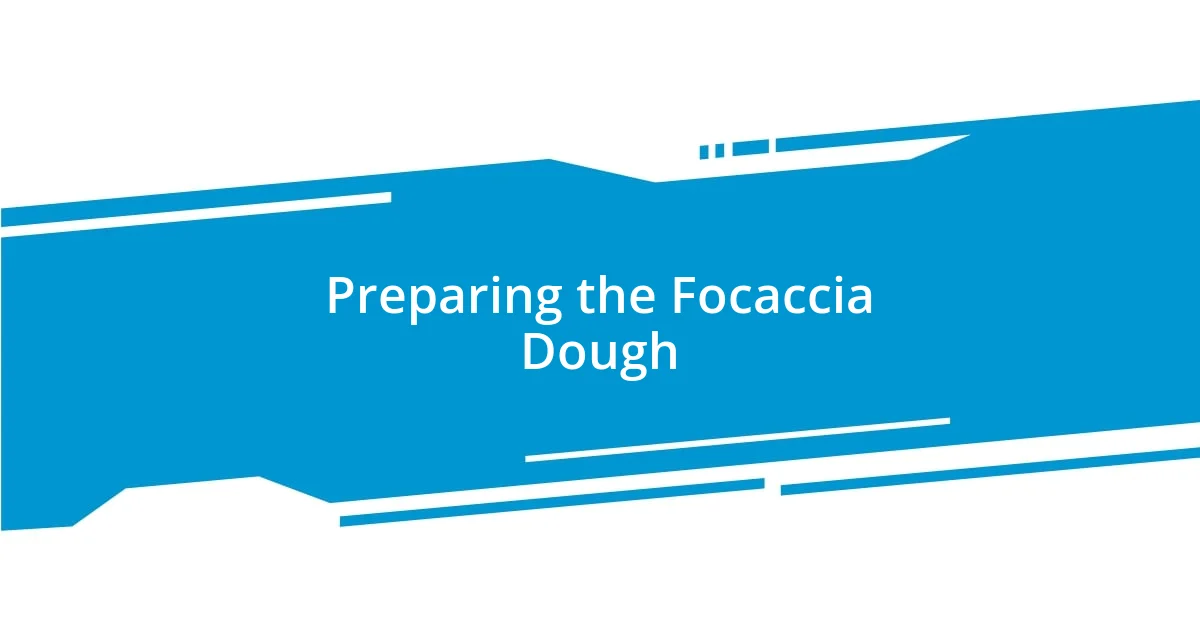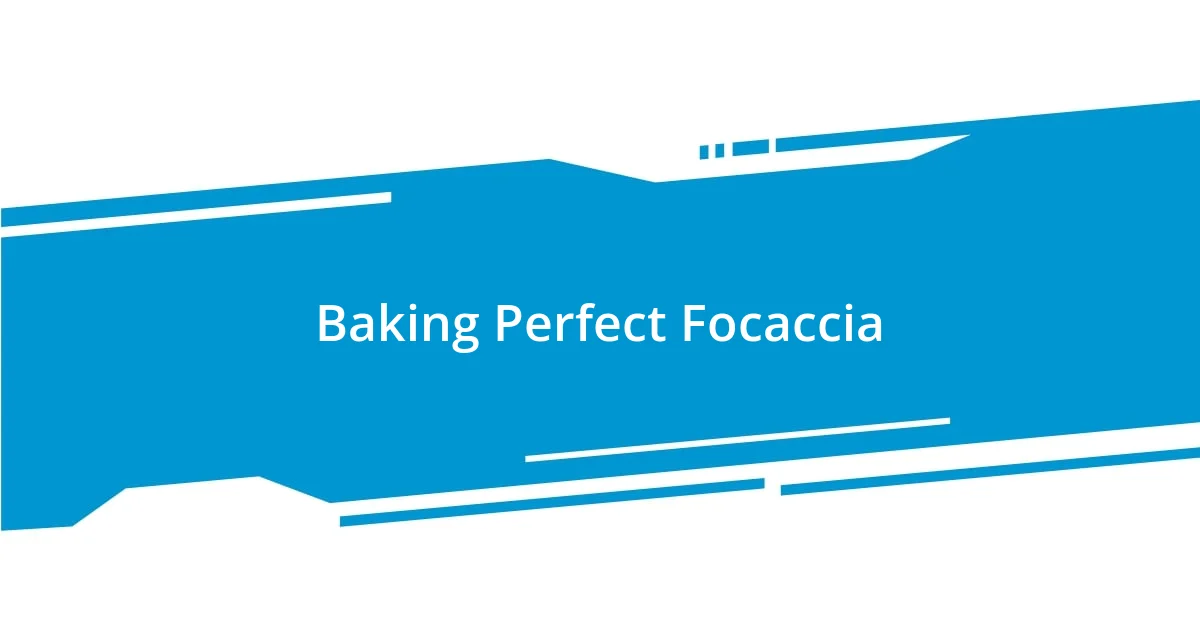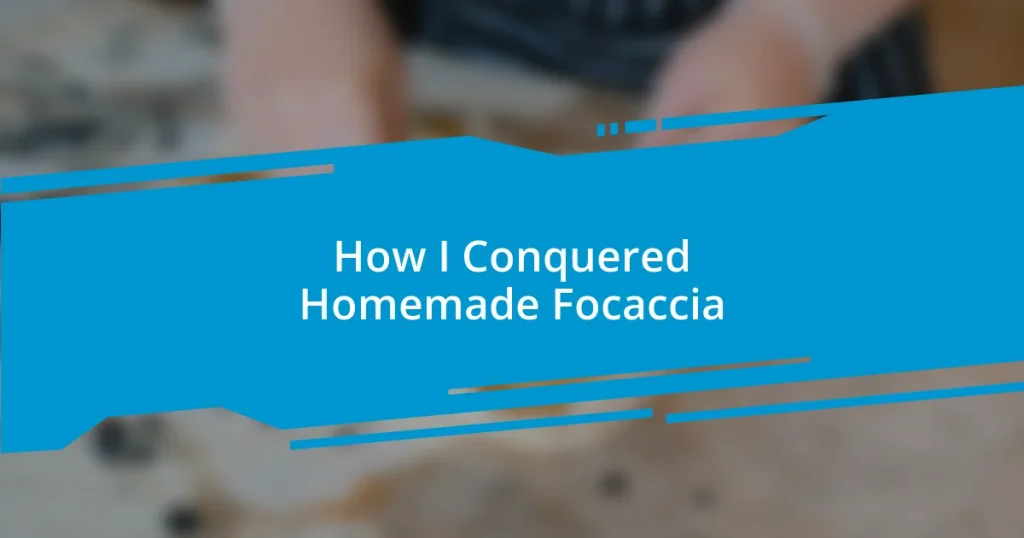Key takeaways:
- Choosing high-quality ingredients such as bread flour, fresh yeast, and robust olive oil is essential for crafting delicious focaccia.
- Proper kneading and proofing techniques, including allowing time for the dough to rise, greatly influence the texture and flavor of the final bread.
- Experimenting with different toppings enhances the flavor of focaccia, transforming it into a versatile and delightful dish.

Understanding Focaccia Background
Focaccia has deep roots in Italian culinary tradition, particularly in regions like Liguria. I remember the first time I tasted homemade focaccia at a quaint café in Genoa. The aroma wafting through the air was so inviting that I couldn’t resist; it was a simple loaf topped with rosemary and sea salt, yet it felt like a warm embrace.
This bread is more than just a side dish; it’s often used as a base for sandwiches or as an accompaniment to dishes. Have you ever found yourself craving something comforting yet versatile? Focaccia can be that perfect canvas, whether you’re making a quick lunch or hosting a dinner party.
The beauty of focaccia lies in its simplicity and adaptability. It’s amazing how a basic dough can transform into an array of flavors based on the toppings you choose. When I first experimented with toppings ranging from olives to sun-dried tomatoes, I felt a sense of excitement; every batch felt like a new adventure waiting to unfold.

Choosing the Right Ingredients
Choosing the right ingredients is crucial in crafting the perfect focaccia. I recall my early attempts, where I couldn’t quite grasp why my dough didn’t match the heavenly loaves I had tasted. After some trial and error, I realized that quality ingredients are the backbone of a successful focaccia.
Here are the essentials I learned to focus on:
- Flour: Look for bread flour or all-purpose flour with a high protein content to give your focaccia that delightful chewy texture.
- Yeast: Fresh yeast can make a significant difference in flavor and rise. If you use active dry yeast, ensure it’s fresh.
- Olive Oil: A robust extra virgin olive oil enhances flavor and creates that delicious golden crust.
- Salt: Sea salt not only enhances taste but also contributes to the dough’s structure.
- Toppings: Fresh herbs and seasonal vegetables bring your focaccia to life; I’ve found that using ingredients from my garden adds a personal touch that elevates the dish.
Every time I whip up a batch, I pour a little extra love into the ingredients, remembering how each one plays a role in the final masterpiece.

Preparing the Focaccia Dough
Preparing the dough is where the magic begins. I fondly recall the feeling of sprouting enthusiasm when I combined flour, yeast, and water for the first time. It’s like a science experiment: you mix those ingredients, and within minutes, they start to come alive, transforming into something extraordinary. I swear, watching the dough bubble and rise feels almost like witnessing a tiny miracle in my kitchen.
When it comes to kneading the dough, patience is key. I remember the first time I kneaded by hand; it was therapeutic in a way I hadn’t expected. The smooth texture that develops as you stretch and fold the dough is a rewarding sensation. It took time to learn the right consistency, but once I got it, that delightful softness became something I looked forward to. Having a dough that’s too sticky might feel frustrating, but adding a little flour changes everything. It’s like giving it a little boost—kind of like how a good mentor helps you grow.
Lastly, let’s talk about proving the dough. This is where the real patience comes in. I used to peek at my dough every five minutes, hoping to see it double in size, but instead learned that good things take time! I now let it rest for at least an hour—sometimes longer. I find this waiting period perfect for unwinding and daydreaming about the delicious focaccia coming to life. There’s a certain exhilaration in knowing I’ll soon enjoy every bite of the fruits of my labor.
| Aspect | Key Insight |
|---|---|
| Kneading | Creates a smooth texture; rewarding sensation with hands-on engagement. |
| Proving | Requires patience; allows dough to rise and flavors to develop. |

Shaping and Proofing Techniques
Once my dough is ready, shaping it is where my creativity bursts forth. I remember the first time I stretched it out in a baking pan—I was so unsure. Did I spread it too thin? Would it rise appropriately? As I’ve learned, gently pressing the dough into the pan with my fingertips creates those signature dimples that are not just aesthetic but also essential for trapping olive oil and giving it that delightful crispy edge when baked. Each time I do this, I can’t help but smile at how simple actions yield such delicious results.
Proofing the dough is a crucial part of the process that often tests a baker’s patience. I have tried covering my dough with plastic wrap, only to find it gets too warm and sticky inside. Now, I prefer a damp kitchen towel—it retains moisture without suffocating the dough. There’s a certain joy in watching the dough slowly puff up. Occasionally, I’ll let out small squeals of excitement as it doubles in size, reminding me of how vital proper proofing is for developing that airy texture. Have you felt that thrill when the dough rises just right?
Another tip I picked up is to give the dough a second proof after shaping. I used to think it was optional, but oh, how wrong I was! I now embrace that additional resting time, allowing the dough to relax and develop even more flavor. I find it remarkable how a small change can take my focaccia from good to extraordinary. It’s like a reminder that, much like life, sometimes the best things come to those who wait (and knead and proof).

Baking Perfect Focaccia
Baking focaccia is an experience that brings pure joy, especially when it comes to the actual baking process. I remember the first time I opened the oven door to check on my focaccia, and that heavenly aroma hit me like a warm hug. Watching the dough transform into a golden, crispy masterpiece is almost magical. I love how the heat makes those dimples rise—a gentle reminder that the effort put into shaping the dough was absolutely worth it.
Once I’ve pulled my focaccia from the oven, I resist the urge to dive in immediately, though it’s tough! I learned the hard way that allowing it to cool for just a few minutes lets the flavors truly develop. There’s something exhilarating about hearing the sound of the crust crackling as it cools. Just imagine that—what other activities in the kitchen provide both aroma and auditory delight? This simple waiting period builds anticipation and makes each bite all the more rewarding.
I also like to try different toppings before sliding the focaccia into the oven. My first attempt with rosemary and sea salt was a revelation, taking my focaccia from ordinary to extraordinary. It’s exciting to experiment, whether it’s adding cherry tomatoes or a sprinkle of parmesan. Each time I venture into new territory, I wonder, what flavor could I bring to life next? For me, baking focaccia isn’t just about the end product; it’s about the joy of exploration and the delightful surprises each attempt reveals.

Enhancing Flavor with Toppings
Enhancing the flavor of focaccia with toppings has truly transformed my baking experience. I vividly remember the first time I added thinly sliced garlic and rosemary; the aroma was intoxicating! It made me realize how these simple ingredients could elevate the focaccia from a basic bread to a symphony of flavors. Have you ever wondered how the right toppings can completely change the personality of a dish? For me, it’s all in the experimentation.
One delightful topping that I frequently return to is a mix of olives and sun-dried tomatoes. The first time I combined these, I was blown away by the burst of flavor they added. Those savory bites, paired with the soft, airy texture of the focaccia, create such a beautiful contrast. I often find myself daydreaming about new combinations—what if I used fig and blue cheese next time? It feels like a culinary adventure!
Another topping I enjoyed experimenting with was caramelized onions. The sweetness they bring is mind-blowing! I recall caramelizing a batch in my kitchen, the scent filling the air and drawing my family in like moths to a flame. When I topped my focaccia with those luscious onions, I couldn’t help but smile at how something so simple could evoke such joy. Every bite reminded me that cooking is about connecting through flavors, and I love how toppings can make that connection even deeper. What toppings have you tried that made your focaccia sing?

Troubleshooting Common Issues
If your focaccia didn’t rise as expected, it might be due to inactive yeast. I recall the letdown of my first attempt when I realized my yeast was old and ineffective. I think about how important it is to check the expiration date and to “proof” the yeast—simply mixing it with warm water and sugar before adding it to the dough. This little step can make all the difference, as it reassures you that your yeast is ready to work its magic.
Another issue I faced was the dreaded soggy bottom. I remember eagerly pulling my focaccia from the oven, only to discover that the bottom was squishy instead of crispy. In hindsight, the solution was quite simple: just ensure you use a good baking surface, like a preheated baking stone or a cast-iron skillet, which helps in achieving that fantastic crust. It’s amazing how a little planning can prevent such a disappointing outcome!
Lastly, if you find your focaccia too salty, I’ve learned that sometimes it’s the toppings that are to blame. The first time I overdid it with sea salt on top, I was met with a mouthful of regret. Now, I take a measured approach when seasoning, reminding myself that I can always add more later but can’t take any away. Isn’t it fascinating how a little restraint can lead to better results?
















